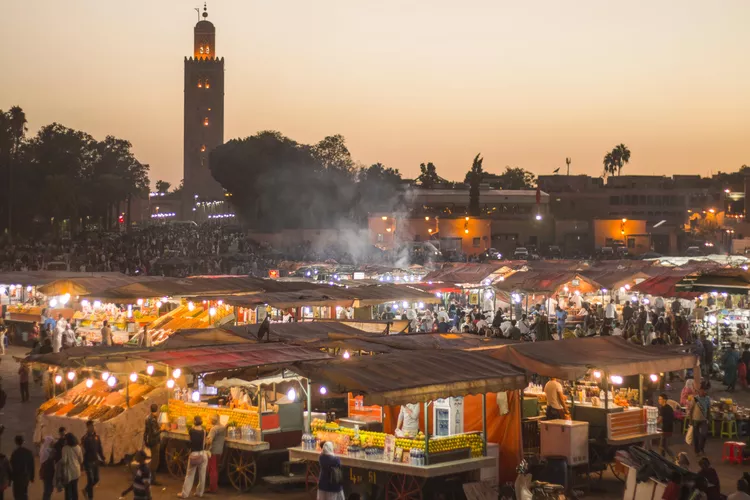Summary
Djemma el Fna: A Cultural Gem in Marrakesh
A triangular plaza at the heart of the Marrakesh medina, Djemma el Fna is the epicenter of Morocco’s most iconic tourist destination. Serving as a gathering place for locals and travelers alike, this square has fostered cultural exchange in Marrakesh since the city’s foundation in the 11th century. With the souk to one side and terraced cafés, gardens, and public buildings to the others, Djemma el Fna buzzes with energy from dawn to dusk. It is the ideal spot to people-watch, sample authentic Moroccan street food, and admire entertainers who have mesmerized crowds for centuries.
History of Djemma el Fna
The square was established along with the rest of Marrakesh’s historic medina by the Almoravids in the mid-11th century. Originally, the largest crowds gathered for public executions, which contributed to Djemma el Fna’s name, meaning “the assembly of the dead.” The square was also a hub for bards and poets, sharing legends and traditions through oral storytelling. This cultural significance led to Djemma el Fna being recognized on UNESCO’s list as a space preserving the “intangible cultural heritage of humanity” in 2008.
In April 2011, a tragic terrorist attack targeted the square’s Argana Café, resulting in the loss of 17 lives. Today, a discreet police presence enhances safety for both visitors and locals.

The Square by Day
During the day, Djemma el Fna serves as a vibrant setting for traditional medicine vendors, dentists, and preachers. Entertainment includes henna artists and snake charmers, while some individuals pose for photographs with illegally kept Barbary macaques, a more troubling aspect of the square. These monkeys, found only in North Africa north of the Sahara Desert, are endangered due to the demand for them as pets and photo opportunities.
Later in the afternoon, the atmosphere shifts as snake charmers give way to other performers, such as magicians, acrobats, fortune-tellers, and storytellers. Visitors, regardless of the language spoken—typically Berber or Arabic—can appreciate their storytelling abilities by observing audience reactions. To quench your thirst, sample the freshly squeezed orange juice offered at stalls lining the square. Water sellers also promote their drinks by ringing brass cups together.
The Square at Night
As sunset approaches, mule carts arrive with makeshift stalls, transforming Djemma el Fna into an expansive open-air dining venue. The square fills with the aroma of grilled meats and spices, creating a captivating atmosphere. Once night falls, communal tables are illuminated by strung light bulbs, hosting diners who gather to indulge in a diverse spread of dishes. Options range from traditional tagines and grilled meats to more exotic local specialties like snail soup and boiled sheep heads.
The lively ambiance is enhanced by the symphony of voices sharing gossip accompanied by Berber musicians, Arabic folk groups, and Gnaoua dance troupes.
Tips for Having Fun and Staying Safe
Given the evolving atmosphere of the square throughout the day, it’s advisable to visit multiple times. Dusk provides a great opportunity to explore permanent cafés along the square’s edge. Consider visiting rooftops for refreshing alcohol-free drinks while enjoying views of the bustling food stalls and hearing the muezzin’s call to prayer. A popular venue is Zeitoun Café, known for its panoramic vistas of the lively scene.
When selecting a stall for dining, choose one frequented by locals, as they typically know where the finest food can be found. If you wish to capture photographs of street performers, be cautious, as many expect a tip. It’s wise to carry small change for purchases and tipping, minimizing the need to pull out larger bills that could attract pickpockets. Store cash securely in a zipped pocket or discreet money belt and avoid wearing flashy jewelry. Additionally, stay vigilant against potential scams, such as vendors offering “gifts” for which payment is later demanded and men attempting to exchange counterfeit currency.





